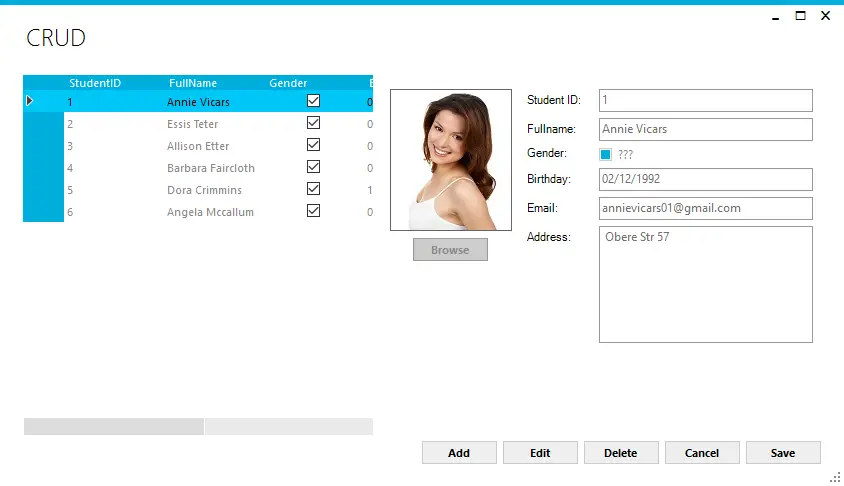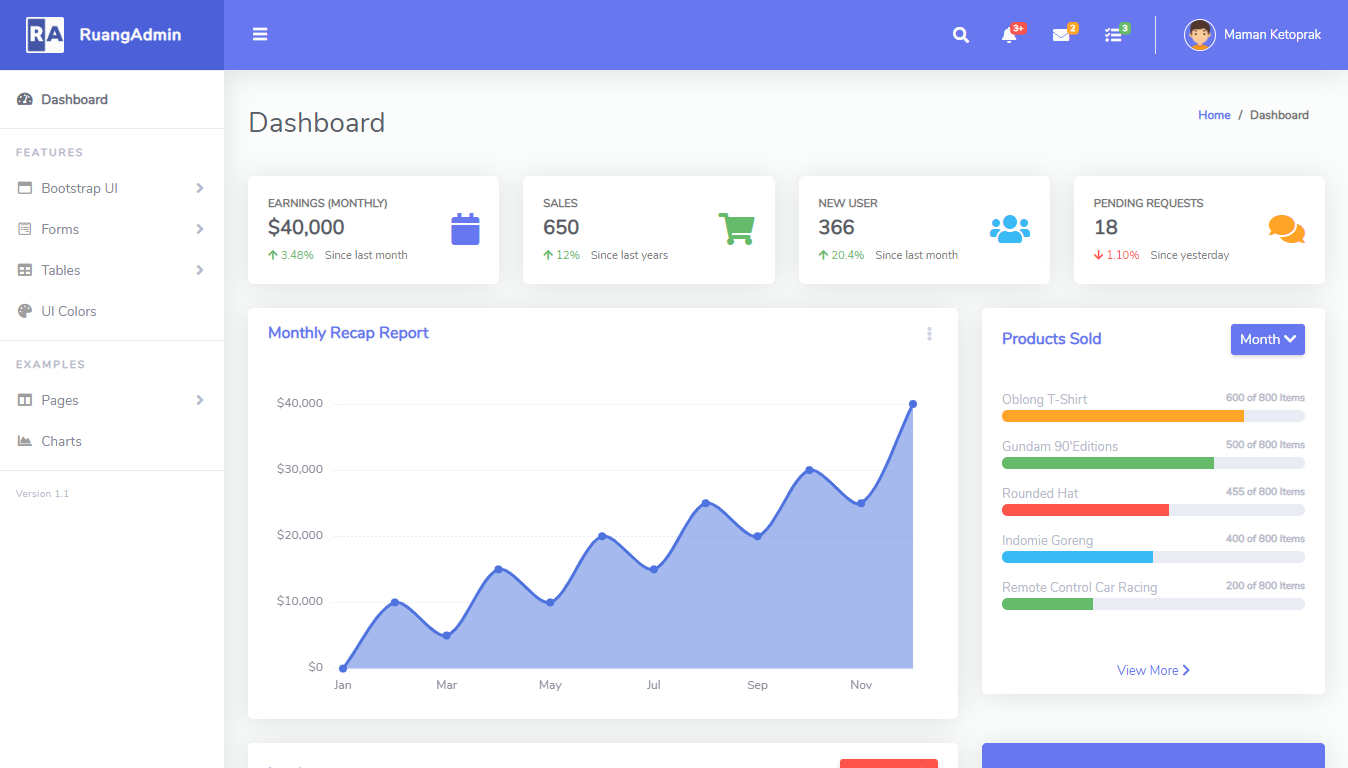How to Insert Update Delete and View data from SQL Database using NPoco ORM in C#
By Tan Lee Published on Jun 18, 2017 8.42K
This guide walks you through creating a simple student management system using C#, SQL Server, and NPoco ORM.
How to Insert Update Delete and View data from SQL Database using NPoco ORM in C#?
Open Visual Studio, then click New Project, then select Visual C# on the left, then Windows and then select Windows Forms Application. Name your project "CRUD" and then click OK
To get started, install the NPoco NuGet package by right-clicking on your project select Manage NuGet Packages -> Search npoco -> Install
Next, Search for 'MetroModernUI' and Install it.

If you don't see the metro framework in your toolbox, you can view How to download and install metro framework
NPoco is a lightweight Micro-ORM designed for simplicity and ease of use. It supports multiple databases, including SQL Server, MySQL, PostgreSQL, Oracle, SQLite, and SQL Compact Edition (SqlCE)
Design a metro form as shown below.

First, create a new database named dbstudent and add a Students table
CREATE TABLE [dbo].[Students](
[StudentID] [int] IDENTITY(1,1) NOT NULL,
[FullName] [nvarchar](100) NULL,
[Birthday] [varchar](10) NULL,
[Gender] [bit] NULL,
[Email] [varchar](100) NULL,
[Address] [nvarchar](250) NULL,
[ImageUrl] [varchar](250) NULL,
CONSTRAINT [PK_Students] PRIMARY KEY CLUSTERED
(
[StudentID] ASC
)WITH (PAD_INDEX = OFF, STATISTICS_NORECOMPUTE = OFF, IGNORE_DUP_KEY = OFF, ALLOW_ROW_LOCKS = ON, ALLOW_PAGE_LOCKS = ON) ON [PRIMARY]
) ON [PRIMARY]This table stores essential details like the student's name, birthday, gender, contact info, and an image URL.
Create a stored procedure to insert, update data to student table as shown below.
create procedure [dbo].[sp_Students_Update]
(
@StudentID int output,
@FullName nvarchar(100),
@Birthday varchar(10),
@Gender bit,
@Email varchar(100),
@Address nvarchar(250),
@ImageUrl varchar(250)
)
as
update Students set FullName = @FullName, Birthday = @Birthday, Gender = @Gender, Email = @Email, [Address] = @Address, ImageUrl = @ImageUrl
where StudentID = @StudentID
go
create procedure [dbo].[sp_Students_Insert]
(
@StudentID int output,
@FullName nvarchar(100),
@Birthday varchar(10),
@Gender bit,
@Email varchar(100),
@Address nvarchar(250),
@ImageUrl varchar(250)
)
as
insert into Students(FullName, Birthday, Gender, Email, [Address], ImageUrl)
values(@FullName, @Birthday, @Gender, @Email, @Address, @ImageUrl)
set @StudentID = SCOPE_IDENTITY()Create an EntityState to track object states (e.g., new, modified, or deleted):
public enum EntityState
{
Unchanged,
Added,
Changed,
Deleted
}In your project's App.config file, add the following connection string to connect to the database.
<configuration>
<connectionStrings>
<add name = "cn" connectionString="Data Source=.;Initial Catalog=dbstudent;User ID=sa;Password=123@qaz;" providerName="System.Data.SqlClient"/>
</connectionStrings>
</configuration>Define the Student class to represent your database table.
public class Student
{
public int StudentID { get; set; }
public string FullName { get; set; }
public string Birthday { get; set; }
public bool Gender { get; set; }
public string Email { get; set; }
public string Address { get; set; }
public string ImageUrl { get; set; }
}
The Form1 constructor initializes the form and sets the default object state:
// Set default object state EntityState objState = EntityState.Unchanged;
On form load, retrieve data from the database and bind it to the UI:
private void Form1_Load(object sender, EventArgs e)
{
try
{
using (IDatabase db = new Database("cn"))
{
//Get students, then add students to binding source
studentBindingSource.DataSource = db.Fetch<Student>();
Student obj = studentBindingSource.Current as Student;
if (obj != null)
{
// Load image if URL exists
if (!string.IsNullOrEmpty(obj.ImageUrl))
pic.Image = Image.FromFile(obj.ImageUrl);
}
pContainer.Enabled = false;
}
}
catch (Exception ex)
{
MetroFramework.MetroMessageBox.Show(this, ex.Message, "Message", MessageBoxButtons.OK, MessageBoxIcon.Error);
}
}
Set the state to EntityState.Added, reset the form, and prepare for data entry:
private void btnAdd_Click(object sender, EventArgs e)
{
objState = EntityState.Added;
pic.Image = null;
pContainer.Enabled = true;
//Add new student to binding source
studentBindingSource.Add(new Student());
studentBindingSource.MoveLast();
txtFullName.Focus();
}Enable editing mode by setting the state to EntityState.Changed:
private void btnEdit_Click(object sender, EventArgs e)
{
objState = EntityState.Changed;
pContainer.Enabled = true;
txtFullName.Focus();
}Confirm deletion and remove the record:
private void btnDelete_Click(object sender, EventArgs e)
{
objState = EntityState.Deleted;
if (MetroFramework.MetroMessageBox.Show(this, "Are you sure want to delete this record?", "Message", MessageBoxButtons.YesNo, MessageBoxIcon.Question) == DialogResult.Yes)
{
try
{
Student obj = studentBindingSource.Current as Student;
if (obj != null)
{
using (IDatabase db = new Database("cn"))
{
//Execute query to delete data
db.Execute("delete from Students where StudentID = @StudentID", new { StudentID = obj.StudentID });
studentBindingSource.RemoveCurrent();
pContainer.Enabled = false;
pic.Image = null;
objState = EntityState.Unchanged;
}
}
}
catch (Exception ex)
{
MetroFramework.MetroMessageBox.Show(this, ex.Message, "Message", MessageBoxButtons.OK, MessageBoxIcon.Error);
}
}
}Save new or updated data based on the object's state:
private void btnSave_Click(object sender, EventArgs e)
{
try
{
studentBindingSource.EndEdit();
Student obj = studentBindingSource.Current as Student;
if (obj != null)
{
using (IDatabase db = new Database("cn"))
{
if (objState == EntityState.Added)
{
//Execute store to insert data, then get output parameter
SqlParameter pId = new SqlParameter("@StudentID", SqlDbType.Int) { Direction = ParameterDirection.Output };
Sql result = Sql.Builder.Append("sp_Students_Insert @StudentID out, @FullName, @Birthday, @Gender, @Email, @Address, @ImageUrl", new
{
StudentID = pId,
FullName = obj.FullName,
Birthday = obj.Birthday,
Gender = obj.Gender,
Email = obj.Email,
Address = obj.Address,
ImageUrl = obj.ImageUrl
});
db.Execute(result);
obj.StudentID = (int)pId.Value;
}
else if (objState == EntityState.Changed)
{
//Execute stored procedure to update database
db.Execute("sp_Students_Update", CommandType.StoredProcedure, new { StudentID = obj.StudentID, FullName = obj.FullName, Gender = obj.Gender, Email = obj.Email, Address = obj.Address, Birthday = obj.Birthday, ImageUrl = obj.ImageUrl });
}
metroGrid.Refresh();
pContainer.Enabled = false;
objState = EntityState.Unchanged;
}
}
}
catch (Exception ex)
{
MetroFramework.MetroMessageBox.Show(this, ex.Message, "Message", MessageBoxButtons.OK, MessageBoxIcon.Error);
}
}Handle image upload and display using the OpenFileDialog:
private void btnBrowse_Click(object sender, EventArgs e)
{
using (OpenFileDialog ofd = new OpenFileDialog() { Filter = "JPEG|*.jpg|PNG|*.png", ValidateNames = true })
{
if (ofd.ShowDialog() == DialogResult.OK)
{
// Load image from file to picturebox control
pic.Image = Image.FromFile(ofd.FileName);
// Get current student, then set image url
Student obj = studentBindingSource.Current as Student;
if (obj != null)
obj.ImageUrl = ofd.FileName;
}
}
}Implement the Windows Forms Application
using NPoco;
using System;
using System.Data;
using System.Data.SqlClient;
using System.Drawing;
using System.Windows.Forms;
namespace CRUD
{
public partial class Form1 : MetroFramework.Forms.MetroForm
{
public Form1()
{
InitializeComponent();
}
private void btnCancel_Click(object sender, EventArgs e)
{
// Disable the input container to prevent further edits.
pContainer.Enabled = false;
// Reset the bindings on the form to undo any changes to the data.
studentBindingSource.ResetBindings(true);
// Reload the form to restore the original data and UI state.
this.Form1_Load(sender, e);
}
private void metroGrid_CellClick(object sender, DataGridViewCellEventArgs e)
{
// Get the current student object selected in the data binding source.
Student obj = studentBindingSource.Current as Student;
// Check if the current student object is not null.
if (obj != null)
{
// If the student has an image URL, display the image in the PictureBox control.
if (!string.IsNullOrEmpty(obj.ImageUrl))
pic.Image = Image.FromFile(obj.ImageUrl);
}
}
}
}VIDEO TUTORIAL
- How to Insert Update Delete View and Search data from SQL Server in C#
- How to Insert Update Delete data in Database from DataGridView in C#
- How to Insert Update Delete View data in SQL Server using 3 Tiers in C#
- How to Insert Update Delete Select in SQL Server in C#
- How to Insert Update Delete Search data from local database in C#
- How to Insert Update Delete View and Search data from MS Access in C#
- Insert Update Delete and View data from SQL Database using ORM Lite in C#
- How to Insert Update Delete Search Records in C#





